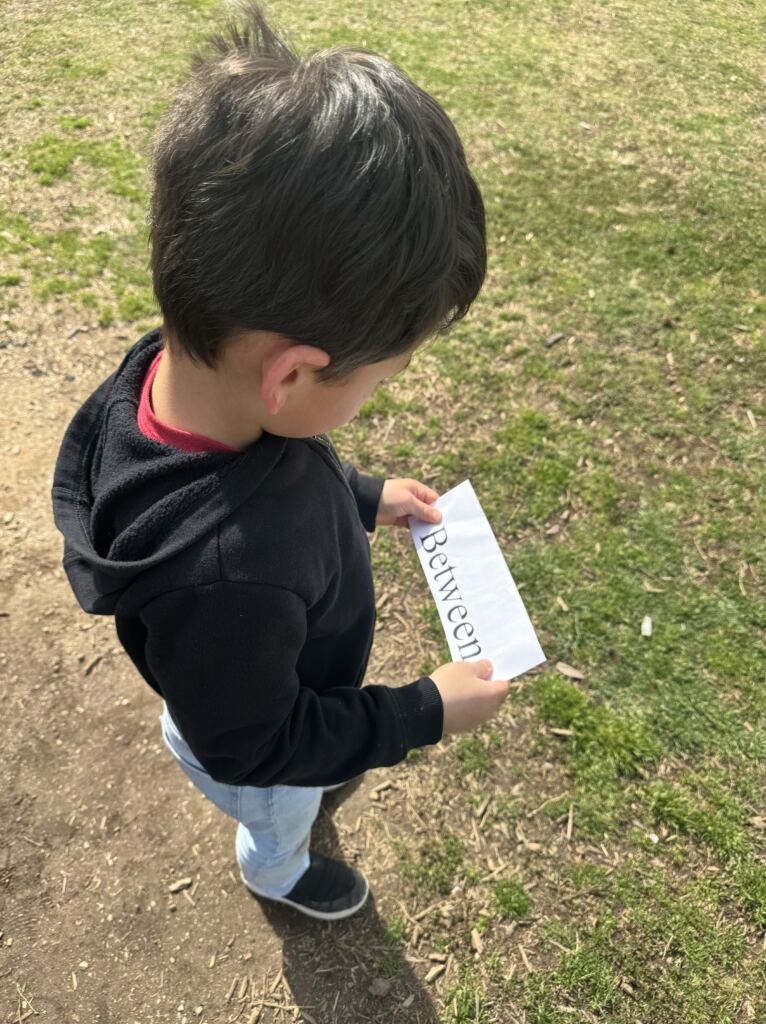Seeing the Science in Child’s Play
April 4, 2024
They were looking for treasure. Together, they had spent the morning preparing for their search by reviewing maps marked with gold stars and honing their spatial relationship skills.
On a clear, cool day in late February 2024, a dozen young Durham scientists working in groups combed through a grassy area scanning the ground, intent on their mission. They were looking for treasure. Together, they had spent the morning preparing for their search by reviewing maps marked with gold stars and honing their spatial relationship skills. Behind them, their Durham PreK teacher, Arianna Holoman, along with Nita McAdoo, Instructional Support Manager for Durham PreK, offered encouragement.
Earlier that morning, Holoman and McAdoo had led these investigators in an activity called “Bridges and Tunnels,” designed to teach preschoolers the meaning and use of directional words – up/down, in/out, backward/forward, over/under. Holoman said this introduction to spatial concepts was meant to help the students, “use the positional words to figure out where the stuff was hidden, like underneath the box or inside the slide.” McAdoo added that, “for preschoolers, an awareness or understanding of spatial concepts and relationships usually predicts later success in math, reading, and following directions.”

McAdoo’s work with Holomon and her classroom is an extension of recent training Durham PreK teachers received from the federally funded STEM Innovation for Inclusion in Early Education Center, or STEMI2E2, housed at UNC Chapel Hill’s Frank Porter Graham Child Development Institute (FPG). But Chih-Ing Lim, the national STEMI2E2 Center’s Senior Technical Assistance Specialist, notes that resources like these for helping children to develop STEM-related concepts and thinking skills are not only for teaching professionals but also for families and caregivers. The Center offers a variety of resources parents can use to support young STEM learners. The core learning materials also guide users in adapting learning environments that help to ensure children with disabilities can fully participate.
resources like these for helping children to develop STEM-related concepts and thinking skills are not only for teaching professionals but also for families and caregivers.
“One of our priorities is to affirm children's STEM identity. We know kids who have disabilities as well as those who are Black and brown are typically not in that STEM pipeline because, probably early on, they do not see enough representation of scientists and mathematicians who are doing the things that we want them to get excited about.” She adds that, at times, “families do not feel as comfortable with STEM because they think that they need to know everything or know when the child gives the right answer,” but according to Lim, the most important thing is, “modeling that sense of curiosity,” perhaps answering a child’s questions with “Oh, I’m not really sure. Let’s check it out together.”

The STEMI2E2 Center’s Jessica Amsbary recommends families visit the general Resources page on the STEMI2E2 Center’s website. She says that the resources available there help caregivers see that much of what they’re already doing with their children “is lending itself to opportunities to learn in STEM.” She points out the My S.T.E.M. Adventure app, which is free and available for download on both Apple and Android devices. “You log into the app, you go outside, you take pictures,” and a story forms from those pictures with a STEM concept embedded. “It's part of your daily routine. It's what you had in your house or what you saw when you went outside,” she adds. Amsbary also points to the Resource for Families section on the general Resources page, which contains storybooks, daily routine explorations, and video demonstrations that offer great examples of “how STEM naturally aligns with play.” She says walks, mealtime, even getting dressed, where “you need to follow a particular set of steps in a particular order… that's algorithmic thinking!” For caregivers, embedding natural opportunities for STEM learning is a matter of perspective. “Many of the opportunities are there already,” says Amsbary, “It's just a matter of that intentionality behind it.”









